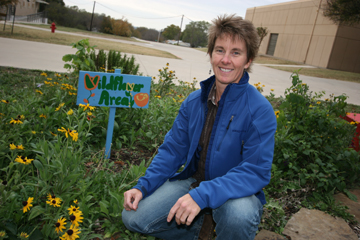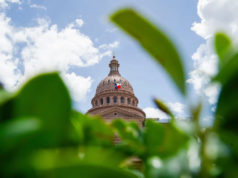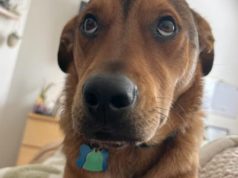Third-graders at Fort Worth’s D. McRae Elementary School harvested 1,982 tomatoes last spring. The experience was good for their diets — and their math skills.
 “I had them do the math for a whole week,” teacher Gail Pirtle said. “We counted, weighed, sorted, and measured. Then we made salsa and green-tomato coffeecake.” At Westcliff Elementary, the school garden has become a virtual open-air lab for many types of learning. Science students have developed temporary habitats for insects to observe their life cycles. Art classes come outside to sketch the plants, and creative writing assignments have grown from the garden. A fifth-grade teacher created a fractions lesson with a recipe for pesto — using student-grown basil. Kerry Renta’s third-grade classes chart plant growth rates, take temperature readings, and learn about natural resources by planting cotton.
“I had them do the math for a whole week,” teacher Gail Pirtle said. “We counted, weighed, sorted, and measured. Then we made salsa and green-tomato coffeecake.” At Westcliff Elementary, the school garden has become a virtual open-air lab for many types of learning. Science students have developed temporary habitats for insects to observe their life cycles. Art classes come outside to sketch the plants, and creative writing assignments have grown from the garden. A fifth-grade teacher created a fractions lesson with a recipe for pesto — using student-grown basil. Kerry Renta’s third-grade classes chart plant growth rates, take temperature readings, and learn about natural resources by planting cotton.
The Westcliff and McRae gardens, and others like them in Fort Worth and nearby school districts, have grown in the past five years from the seeds planted — figuratively and in some cases literally — by landscape architect Stacey Hodge, with financial fertilizer provided by a Fort Worth investment guru’s charity. The Rainwater Environmental Alliance for Learning (REAL) School Gardens project, from a start at Fort Worth’s Sam Rosen Elementary School in 2002, has grown to 37 school gardens in Fort Worth, Arlington, and Watauga, and more campuses are asking to join. Now that the program is doing well here, REAL School is preparing to take its vision to other cities that have expressed interest. “We’re on the cusp of what, I think, is going to happen nationwide,” said Hodge.
On a recent day, Hodge and colleague Eric Vanderbeck were crouched near a chain-link fence at Seminary Hill Elementary School, digging into the dirt that spilled into a dry creek bed. Vanderbeck’s hands emerged with fossilized shells — remnants, he said, of the vast seabed that this part of Texas used to be. The shelly dirt had been removed when the school’s garden was planted nearby. Hodge lifted a limestone slab and gleefully pointed out childhood nightmares underneath — earwigs, centipedes, spiders. Then, noticing a large anthill, the two began tossing around the questions they would pose later at a faculty training session. “Why is the anthill against this rock? Where are they getting their food? Why haven’t they made their home somewhere else?”
Hodge and Vanderbeck’s inquisitive natures, like their willingness to get dirty, are part of their job. The program is aimed at introducing kids to the natural world and encouraging teachers to incorporate its lessons back in the classroom. “We want a child to feel the joy of holding an insect and understand the cycles of that insect,” the REAL School credo says, in part. “We want teachers to talk about geology and point to it, to know that what they teach inside can be taught outside.” The organization’s namesake — and current source of funds — is Richard Rainwater, the billionaire investor who graduated from Paschal High School in ’62, then went off to Stanford University, where he befriended Sid Bass and eventually became the Bass family’s financial architect.
Hodge was first approached by James Freeman, a counselor at Sam Rosen, in late 2002. The school had recently received a $10,000 grant for a garden from Rainwater Charitable Funds and wanted the help of the landscape company Hodge worked for at the time. However, expertise in major commercial landscaping didn’t translate well to a kids’ garden.
“My company had just done things like Sundance Square and Hyatt [Hotels], so we didn’t really know how to handle it,” said Hodge. But she was personally interested and got her boss’ permission to work on plans for the garden at Rosen. Hodge liked the work so much that she left her position at the commercial firm and proposed a gardening program for area elementary schools. Suzy Peacock, director of the Rainwater charity, agreed, and REAL Schools Initiative, as it was known then, was born. The project’s first garden, at Sam Rosen, was dedicated on Earth Day — April 22, 2003.
Her outdoorsy jeans and work boots don’t suggest a sentimental side, but that day, “I had tears streaming down my face,” said Hodge with a laugh. “The kids had written poems about all the vegetables and flowers that had grown within weeks of planting, and I was just boo-hooing.” She is now the program’s design and use coordinator, assisting in the layout and planting of the gardens and helping teachers fashion goals and guidelines for the gardens’ use. Vanderbeck came aboard a year after Hodge. He’d worked previously for 30 years as a horticulturist for Ruth Carter Stevenson (daughter of Amon), and is now the program’s resource coordinator. Many other area schools now want to plant their own REAL plots, but Hodge and Vanderbeck are taking a year off from accepting applications. It has proven difficult, they said, to time all the gardens properly, and they worry that it’s affecting growing seasons and results.
At Seminary Hill, the proof was in the tomatoes. The vines weren’t planted in time to produce ripe tomatoes before the first fall chill. “We’ll try and be here more often next semester and time you so your vegetables can be put to better use,” Hodge told the teachers. The two experts shared their evaluation of the garden — and its lessons — with the teachers and heard about successes and failures. At one point, they asked the teachers to go find something unusual in the garden and come back to share that with the group — just as the teachers sometimes ask of students. Fingering a large clump of amaranth, kindergarten teacher Kay Scarlett said her students love working outside. “We go and stand in a circle and talk about what we’ve seen in the garden,” she said. “They feel very important when they make an observation.” Later, she told Vanderbeck and Hodge that much of what her students planted had been eaten by insects. There’s no easy solution to why that happened, the gardeners told her — but the insect damage could be used as another way to get kids asking questions about the plants and bugs.
Afterward, Vanderbeck explained that, despite its successes, the REAL School program has faced obstacles beyond insects and bad weather — including, sometimes, faculty. “Some teachers don’t like being outside, period,” he said. “Then there are those who just don’t know what to do with a garden: We’ll give them seed packages with all the directions, and they’ll pour the entire package into one 6-inch-deep hole, then call us and say that nothing grew. “That’s another thing we want to try and change,” he said, “because a hundred years ago, we were all very close to nature. That was our only subsistence, but we’ve gotten so far from it today. We want to take students and teachers back to that relationship with Mother Earth.”
A local partnership is helping REAL School to educate teachers about nature’s resources. On at least four Saturdays each school year, the organization teams up with the Botanical Research Institute of Texas (BRIT) for a day of professional development — studying everything from monarch butterflies to using photography in the garden. As a result, the teachers are learning along with their students — and not just about growing plants. When the garden at McRae was started three years ago, many of the plants were stolen within days. But once the students were told that the garden was their creation and responsibility, things stopped disappearing, Hodge said.
Now the school has three gardens; one up front, with Mexican mint marigold, anise, sunflowers, rosemary, giant radishes, quinces, and lemonbalm; one by the portable classrooms; and another “secret garden” for younger students. There are stone slabs that the students treat as seats for a “theater”; cherry laurel bushes serve as a backdrop. Hodge and Vanderbeck helped plant vines that, in the springtime, snake up wooden sticks held together to look like teepees. But some of the McRae gardens may not be around much longer. The recently passed bond proposal and the fact that McRae houses 900 students in a school built for 500 dictate that new classrooms probably will be built on top of the gardens, which saddens Pirtle. “They’re planning to build right over the kids’ hard work,” she said. At Westcliff, fifth-grade science teacher Scott Feille praised the garden as “the perfect tool for teaching.” “Instead of learning about the nitrogen cycle from a book or a lecture, my students get to plant peas and monitor the level of nitrogen, phosphorus, and potassium in various soils to see if legumes really do produce a measurable difference in soil nutrients,” he said. The experiment transforms a bunch of big words into earthy reality.
The school now has an E Club, which helps maintain the garden. The latest project is preparing more beds for native Texas plants. Many teachers have also gotten into the swing of things. One teacher revealed that the school garden had helped him get back to the outdoor life he’d known as a boy growing up on a farm. A couple who teach at McRae began growing vegetables at home; third-grade teacher Renta practically designed Westcliff’s garden himself. “This is exactly the kind of response we were hoping for but never thought we’d get,” Hodge said. Recently, Hodge said, the REAL School leaders have heard from teachers in Florida and Houston who want more information on the program. They’ve also been contacted by the San Francisco Green Schoolyard Alliance, for assistance with that city’s school gardens program. “Chances are that that will be our first partnership,” she said — and a step toward growing a national crop of school gardens.
Back at Westcliff, just one garden proved enough: A student responded to REAL School questionnaire by saying that before her school’s garden was planted, she was an indoor person. But now, she helps her mother in their garden at home and likes to be outside. “This,” said Renta, “is what REAL School has done for our urban students.”
You can reach Nandini Balial at nandini.balial@fwweekly.com.











